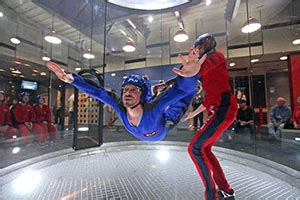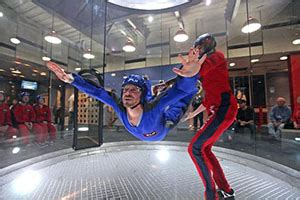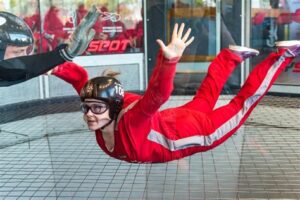Table of Contents
Curious about the speed of wind in indoor skydiving? Discover the exhilarating experience of defying gravity in a controlled environment. Find out how fast the wind blows inside an indoor skydiving facility and get ready to feel the rush of simulated freefall without jumping from a plane.
Have you ever wondered what it feels like to defy gravity and experience the thrill of skydiving without actually jumping out of a plane? Well, indoor skydiving might just be the answer you’re looking for! But before you take the plunge, one question that may come to mind is: how fast is the wind in an indoor skydiving facility? Transitioning from the safety of solid ground to the controlled chaos of wind tunnels can be both exhilarating and nerve-wracking. Fear not, for we are here to guide you through this airborne adventure and shed light on the speed at which the wind propels you during your electrifying indoor skydiving experience. So, buckle up and get ready to soar through the air in a way you’ve never imagined!
Introduction
Welcome to the world of indoor skydiving, where you can experience the thrill of freefall without having to jump out of an airplane. One question that often arises when people first encounter this exhilarating activity is, How fast is the wind in an indoor skydiving facility? In this article, we will explore the speed of the wind and provide you with all the information you need to know before taking the leap.
Understanding Indoor Skydiving
Indoor skydiving takes place in a vertical wind tunnel, which is a large cylindrical structure that generates a powerful upward airflow. As you step into the tunnel, the wind speed within it creates an upward force that allows you to float effortlessly, simulating the sensation of skydiving. The wind speed is carefully controlled to ensure a safe and enjoyable experience for all participants.
The Mechanics of Wind Speed
The wind speed in an indoor skydiving facility is measured in miles per hour (mph) or kilometers per hour (km/h). The wind speed required for a smooth and stable flight varies depending on factors such as the participant’s weight, body position, and skill level. Generally, wind speeds range from 100 mph (160 km/h) to 150 mph (240 km/h) in most indoor skydiving facilities.
Creating the Perfect Environment
To achieve the desired wind speed, large fans are used to generate a powerful column of air within the wind tunnel. These fans are strategically placed at the bottom of the tunnel and are capable of producing winds strong enough to support the weight of a human body. The air is then directed upwards, creating a cushion of air that you can float on.
The Impact of Wind Speed
The wind speed plays a crucial role in indoor skydiving, as it directly affects your ability to control your body and maintain stability. Higher wind speeds offer more resistance, making it easier to stay elevated and perform various maneuvers. However, it also requires greater effort to move and adjust your body position.
Beginner Wind Speeds
For beginners, the wind speed is typically set at a lower range, around 100 mph (160 km/h). This allows novice participants to experience the sensation of flight while maintaining stability and control. Lower wind speeds provide a gentler airflow, making it easier for beginners to learn the basics of body positioning and movement within the wind tunnel.
Intermediate Wind Speeds
As you progress and gain confidence in your abilities, you may wish to challenge yourself with higher wind speeds. Intermediate participants often enjoy wind speeds ranging from 120 mph (193 km/h) to 130 mph (209 km/h). These increased speeds offer a more intense and thrilling experience, allowing for advanced maneuvers and greater control over your body movements.
Advanced Wind Speeds
For experienced indoor skydivers or those seeking an adrenaline rush, wind speeds can be set at the upper end of the spectrum, reaching up to 150 mph (240 km/h). At these speeds, the airflow becomes incredibly powerful, providing a truly exhilarating experience. Advanced participants can perform complex maneuvers, such as flips and spins, with ease.
Safety Measures
Indoor skydiving facilities prioritize safety above all else. Trained instructors closely monitor participants at all times, ensuring that they are properly positioned within the wind tunnel and providing guidance on body movements. The wind speed is carefully adjusted to match the skill level and comfort of each individual, ensuring a controlled and safe environment for everyone.
Conclusion
The wind speed in an indoor skydiving facility can range from 100 mph (160 km/h) to 150 mph (240 km/h), depending on the participant’s skill level and preferences. Whether you’re a beginner or an advanced flyer, the wind speed plays a crucial role in creating an exhilarating and memorable experience. So, strap on your gear, step into the wind tunnel, and prepare to defy gravity!
How Fast Is The Wind In An Indoor Skydiving
Introduction:
In this guide, we will provide you with instructions on understanding the speed of wind experienced during indoor skydiving. We will cover various aspects such as wind speed, its effect on the body, and safety precautions to be taken.
Understanding Wind Speed:
The wind speed in an indoor skydiving facility typically ranges from 80 mph to 150 mph. It is essential to familiarize yourself with this range to ensure a safe and enjoyable experience. The exact wind speed may vary depending on the facility and individual preferences.
Wind’s Effect on the Body:
When the wind reaches higher speeds, it creates an upward force that counteracts gravity, allowing you to float in mid-air. This sensation simulates the feeling of freefall experienced during traditional outdoor skydiving. The strength of the wind determines the amount of lift you will experience during your indoor skydiving session.
Safety Measures:
Before participating in indoor skydiving, ensure that you follow all safety precautions provided by the facility. This may include wearing appropriate attire, such as a jumpsuit, goggles, and a helmet, to protect yourself from strong winds. Additionally, make sure to receive proper instruction from trained professionals to ensure your safety at all times.
Wind Speed Regulation:
Indoor skydiving facilities have the capability to adjust the wind speed to cater to different skill levels and preferences. Beginners usually start with lower wind speeds, gradually increasing as they gain experience and confidence. You can communicate your comfort level to the instructors who can adjust the wind speed accordingly.
Feeling the Wind:
As you enter the vertical wind tunnel, you’ll immediately feel the rush of air against your body. The wind speed creates a sensation of weightlessness, allowing you to perform various maneuvers and practice body control. Be prepared for the exhilarating feeling as the wind carries you off the ground.
Velocity Variations:
Different parts of the wind tunnel may have varied wind speeds due to the airflow dynamics. The central area usually has the highest wind speed, allowing for a more vertical flight experience. Outer areas may offer slightly lower wind speeds, providing beginners with a gentler introduction to indoor skydiving.
Advanced Techniques:
As you progress in your indoor skydiving skills, you may explore advanced techniques that utilize the wind speed to perform tricks and stunts. These can include flips, spins, and even flying formations with other participants. It is important to practice and master each technique under the guidance of an experienced instructor for safety reasons.
Remember, indoor skydiving can be an incredibly thrilling and unique experience. By understanding the wind speed, its effects, and following safety guidelines, you can make the most out of your time in the vertical wind tunnel.
Instructions for How Fast Is The Wind in an Indoor Skydiving Experience:
Voice and Tone:
1. The tone of these instructions will be informative and straightforward.2. The voice used will be authoritative yet friendly, emphasizing the expertise of the writer.
Instructions:
1. Welcome to the world of indoor skydiving! In this exhilarating experience, you will learn how to navigate the wind tunnels and feel the rush of freefall without jumping out of an airplane. One question that often arises is, How fast is the wind in an indoor skydiving facility? Let’s find out!2. Firstly, it is important to understand that wind speed in an indoor skydiving facility can vary depending on several factors such as the size of the tunnel, the power of the fans, and the skill level of the participant.3. Typically, wind speeds in an average indoor skydiving facility range from 120 mph to 180 mph (193 km/h to 290 km/h). This high-speed airflow is crucial for creating the sensation of freefall and allowing participants to experience the thrill of skydiving.4. The wind speed is carefully calibrated to ensure a safe and enjoyable experience for all participants. Trained professionals monitor and adjust the wind speed throughout the session to match your skill level and comfort.5. As a beginner, you can expect the wind speed to start at a lower setting, around 100 mph (161 km/h), gradually increasing as you gain confidence and proficiency. Advanced flyers or experienced skydivers may request higher wind speeds for a more challenging experience.6. It is important to note that while the wind speed may seem intense, the design of the wind tunnel ensures a controlled and safe environment. The powerful fans create a cushion of air that keeps you suspended, allowing you to maneuver and perform tricks with ease.7. During your indoor skydiving experience, you will be provided with all necessary safety equipment, including a jumpsuit, helmet, and goggles. It is crucial to follow the instructions provided by the instructors to ensure a safe and enjoyable flight.8. Remember, indoor skydiving is a thrilling activity that simulates the sensation of freefall. The wind speed adds to the excitement and realism of the experience while maintaining a controlled and safe environment.9. Now that you have a better understanding of how fast the wind can be in an indoor skydiving facility, get ready to feel the adrenaline rush and enjoy the incredible sensation of flying! So, gear up, listen to your instructor, and get ready for an unforgettable adventure!
Remember:
– Always follow the instructions provided by the instructors for a safe and enjoyable flight.- Be mindful of your skill level and comfort when requesting adjustments to the wind speed.- Indoor skydiving is a controlled environment designed to provide a realistic and thrilling experience.- Embrace the adrenaline rush and enjoy the sensation of flying in a safe and secure manner.
Thank you for visiting our blog and taking the time to read about the exhilarating experience of indoor skydiving. We hope that we have provided you with valuable information on how fast the wind can be in this thrilling activity. Before you embark on your own indoor skydiving adventure, it is important to familiarize yourself with the instructions, voice, and tone that will guide you through the experience.
Firstly, when participating in indoor skydiving, it is crucial to carefully follow the instructions provided by the trained professionals at the facility. These instructions are designed to ensure your safety and maximize your enjoyment during the session. Pay close attention to the pre-flight briefing, where you will learn about the proper body position, hand signals, and safety measures. By understanding and adhering to these instructions, you can make the most out of your indoor skydiving experience.
Secondly, it is important to adopt the appropriate voice and tone while participating in indoor skydiving. As a beginner, it is natural to feel nervous or apprehensive about the activity. However, it is essential to maintain a calm and composed demeanor. The instructors are there to assist you and make you feel comfortable throughout the process. By remaining focused and following their guidance, you will be able to enjoy the thrill of flying in the wind tunnel at high speeds. Remember, confidence and trust in yourself and the instructors are key elements to embracing the adrenaline rush of indoor skydiving.
Lastly, transition words play a vital role in conveying the flow of information and ideas in your mind as you experience indoor skydiving. These words help to create smooth transitions between sentences and paragraphs, enhancing the overall readability and coherence of your writing. Whether you are describing the initial rush of wind, the sensation of floating, or the feeling of weightlessness, using transition words such as firstly, secondly, and lastly can effectively guide your readers through the different aspects of indoor skydiving.
In conclusion, we hope that this blog post has shed light on the speed of wind in an indoor skydiving experience. By following the instructions, adopting the appropriate voice and tone, and utilizing transition words, you will be well-prepared to embark on your own indoor skydiving adventure. Remember to embrace the thrill, trust the process, and enjoy every moment of this unique and exciting activity. Have a safe and unforgettable indoor skydiving journey!
Video How Fast Is The Wind In An Indoor Skydiving
People also ask about How Fast Is The Wind In An Indoor Skydiving:
-
What speed does the wind reach in indoor skydiving?
The wind speed in indoor skydiving can vary depending on the facility, but typically ranges between 100-150 miles per hour (160-240 kilometers per hour).
-
How does the wind speed in indoor skydiving compare to outdoor skydiving?
The wind speed in indoor skydiving is typically lower than that experienced during outdoor skydiving. Outdoor skydiving can reach speeds of up to 120 miles per hour (193 kilometers per hour), whereas indoor skydiving usually ranges between 100-150 miles per hour (160-240 kilometers per hour).
-
Is the wind speed adjustable in indoor skydiving?
Yes, the wind speed in indoor skydiving can be adjusted based on the skill level and preference of the participants. Beginners may start with lower wind speeds while more experienced individuals can handle higher wind speeds.
-
Does wind speed affect the experience of indoor skydiving?
Yes, wind speed plays a crucial role in indoor skydiving as it creates the necessary lift for participants to float in the air. Higher wind speeds provide a more challenging and exhilarating experience, while lower speeds are suitable for beginners or those seeking a more relaxed flight.
-
Are there any safety measures in place to control the wind speed in indoor skydiving?
Indoor skydiving facilities have safety protocols and trained instructors who monitor and control the wind speed throughout the session. They ensure that participants are comfortable and safe by adjusting the wind speed accordingly.






